Page 247 of 450
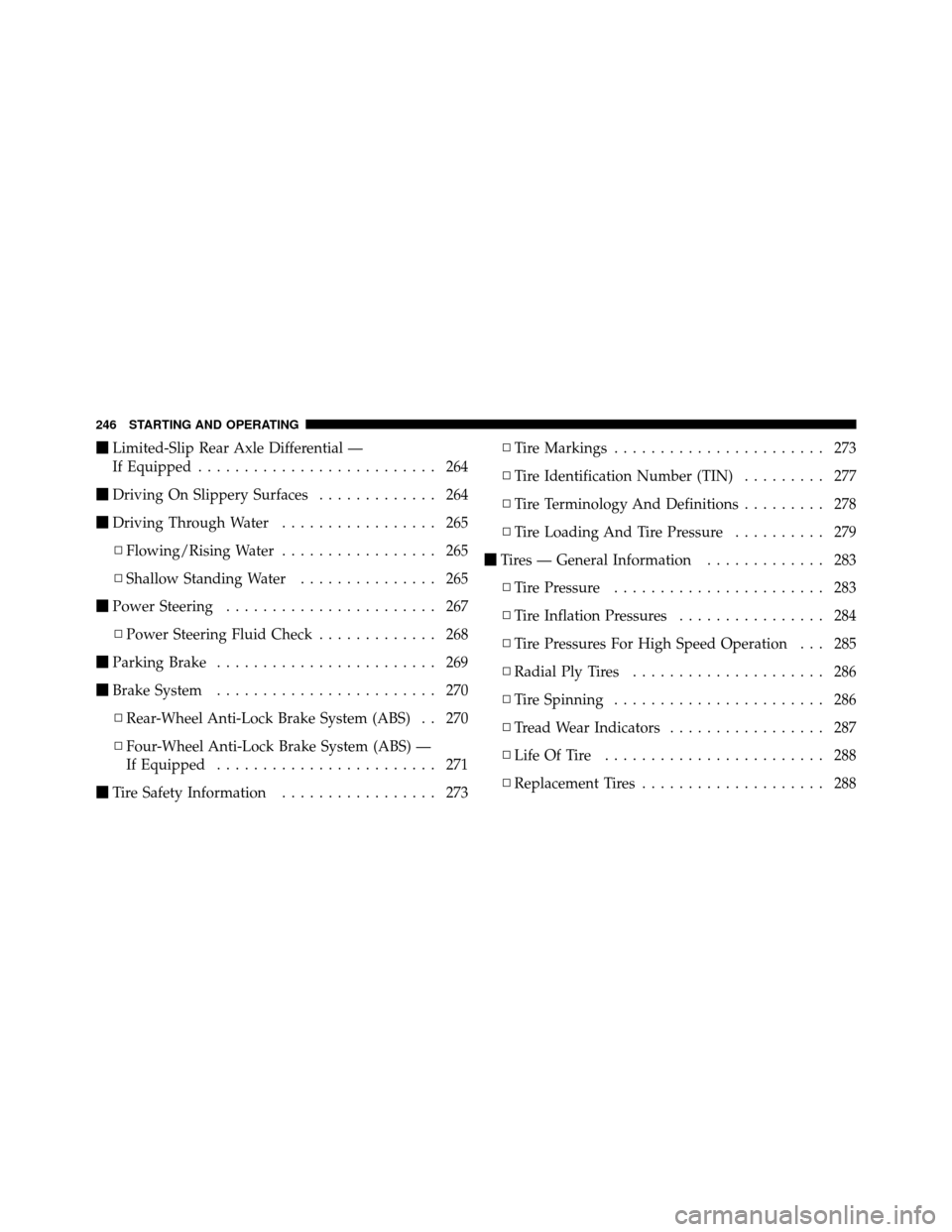
�Limited-Slip Rear Axle Differential —
If Equipped .......................... 264
� Driving On Slippery Surfaces ............. 264
� Driving Through Water ................. 265
▫ Flowing/Rising Water ................. 265
▫ Shallow Standing Water ............... 265
� Power Steering ....................... 267
▫ Power Steering Fluid Check ............. 268
� Parking Brake ........................ 269
� Brake System ........................ 270
▫ Rear-Wheel Anti-Lock Brake System (ABS) . . 270
▫ Four-Wheel Anti-Lock Brake System (ABS) —
If Equipped ........................ 271
� Tire Safety Information ................. 273 ▫
Tire Markings ....................... 273
▫ Tire Identification Number (TIN) ......... 277
▫ Tire Terminology And Definitions ......... 278
▫ Tire Loading And Tire Pressure .......... 279
� Tires — General Information ............. 283
▫ Tire Pressure ....................... 283
▫ Tire Inflation Pressures ................ 284
▫ Tire Pressures For High Speed Operation . . . 285
▫ Radial Ply Tires ..................... 286
▫ Tire Spinning ....................... 286
▫ Tread Wear Indicators ................. 287
▫ Life Of Tire ........................ 288
▫ Replacement Tires .................... 288
246 STARTING AND OPERATING
Page 268 of 450
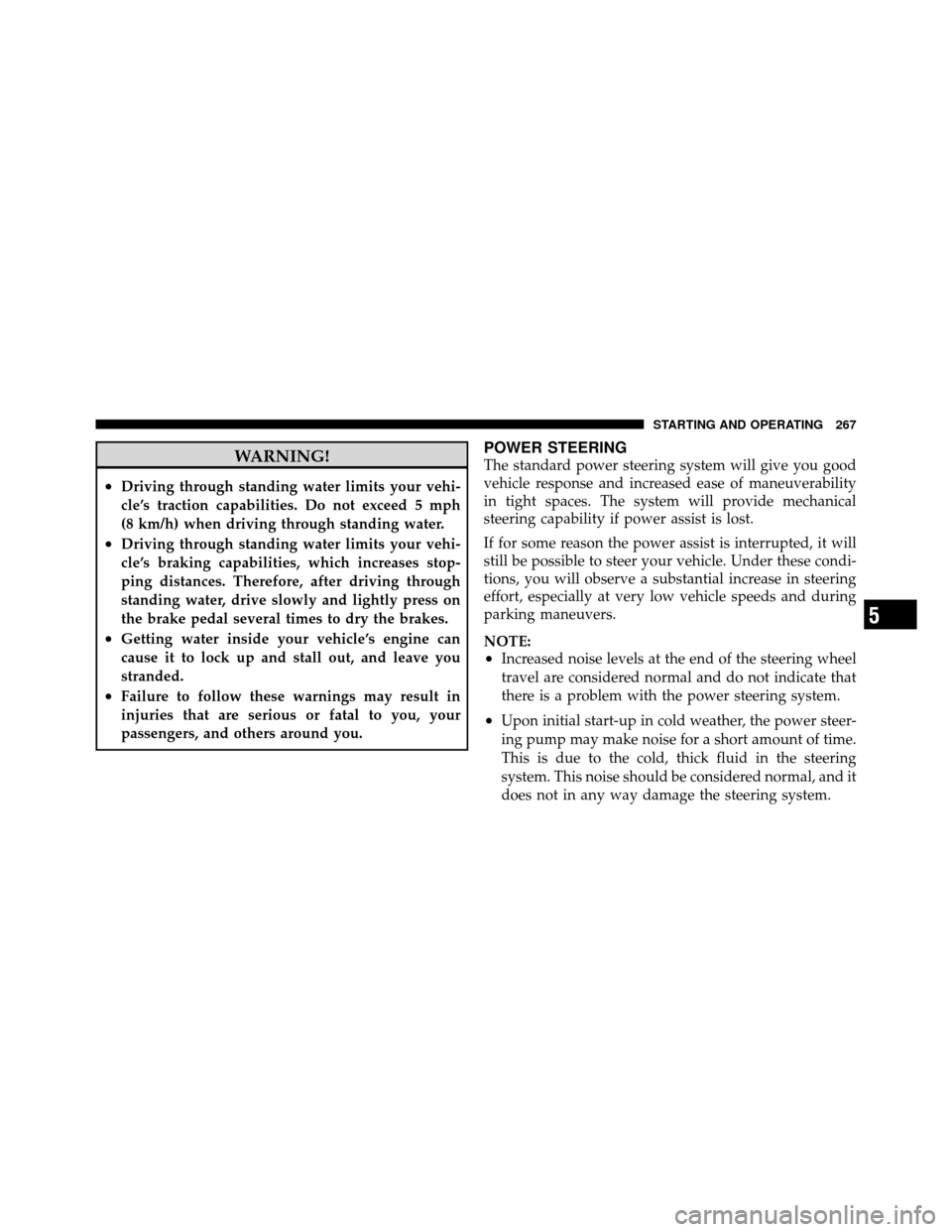
WARNING!
•Driving through standing water limits your vehi-
cle’s traction capabilities. Do not exceed 5 mph
(8 km/h) when driving through standing water.
•Driving through standing water limits your vehi-
cle’s braking capabilities, which increases stop-
ping distances. Therefore, after driving through
standing water, drive slowly and lightly press on
the brake pedal several times to dry the brakes.
•Getting water inside your vehicle’s engine can
cause it to lock up and stall out, and leave you
stranded.
•Failure to follow these warnings may result in
injuries that are serious or fatal to you, your
passengers, and others around you.
POWER STEERING
The standard power steering system will give you good
vehicle response and increased ease of maneuverability
in tight spaces. The system will provide mechanical
steering capability if power assist is lost.
If for some reason the power assist is interrupted, it will
still be possible to steer your vehicle. Under these condi-
tions, you will observe a substantial increase in steering
effort, especially at very low vehicle speeds and during
parking maneuvers.
NOTE:
•Increased noise levels at the end of the steering wheel
travel are considered normal and do not indicate that
there is a problem with the power steering system.
•Upon initial start-up in cold weather, the power steer-
ing pump may make noise for a short amount of time.
This is due to the cold, thick fluid in the steering
system. This noise should be considered normal, and it
does not in any way damage the steering system.
5
STARTING AND OPERATING 267
Page 269 of 450
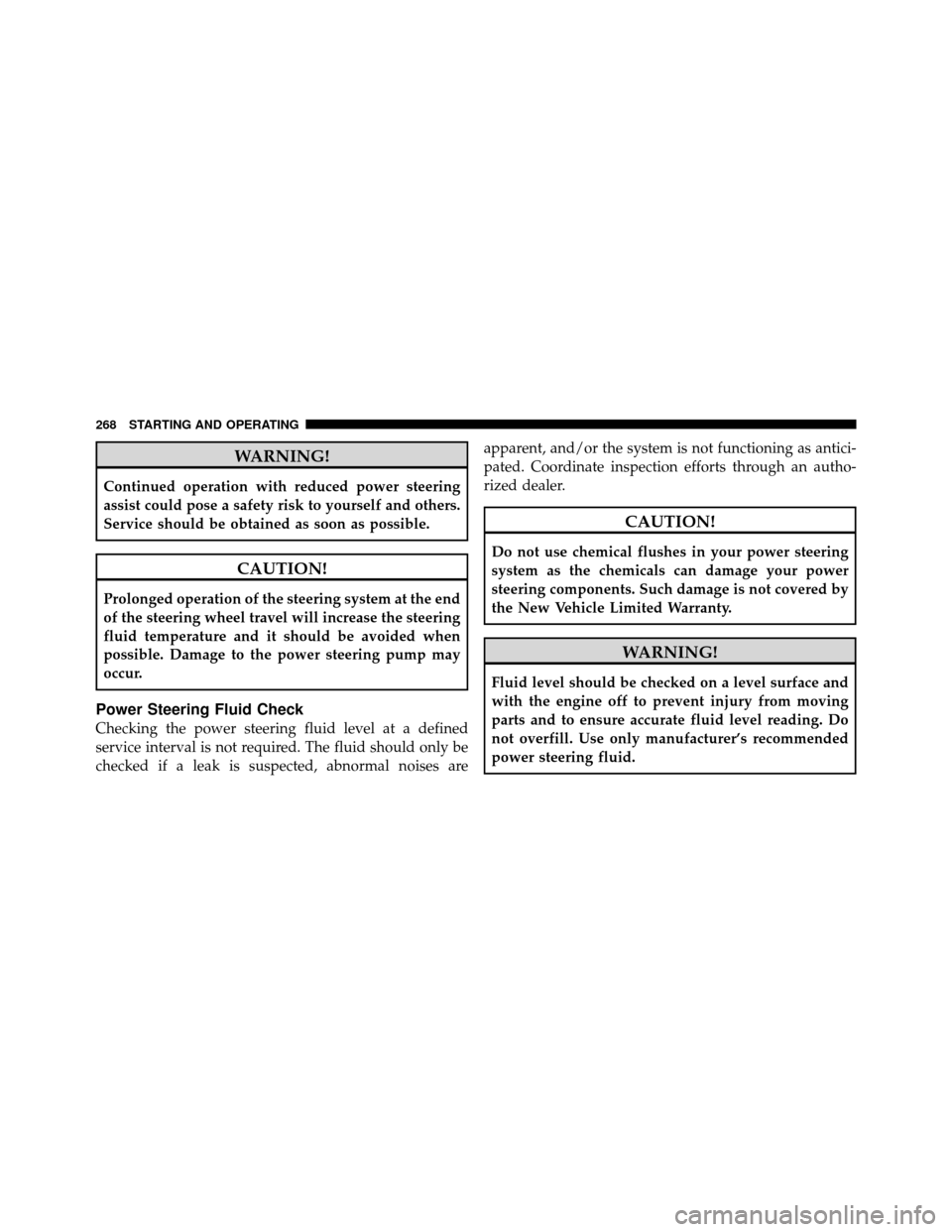
WARNING!
Continued operation with reduced power steering
assist could pose a safety risk to yourself and others.
Service should be obtained as soon as possible.
CAUTION!
Prolonged operation of the steering system at the end
of the steering wheel travel will increase the steering
fluid temperature and it should be avoided when
possible. Damage to the power steering pump may
occur.
Power Steering Fluid Check
Checking the power steering fluid level at a defined
service interval is not required. The fluid should only be
checked if a leak is suspected, abnormal noises areapparent, and/or the system is not functioning as antici-
pated. Coordinate inspection efforts through an autho-
rized dealer.
CAUTION!
Do not use chemical flushes in your power steering
system as the chemicals can damage your power
steering components. Such damage is not covered by
the New Vehicle Limited Warranty.
WARNING!
Fluid level should be checked on a level surface and
with the engine off to prevent injury from moving
parts and to ensure accurate fluid level reading. Do
not overfill. Use only manufacturer’s recommended
power steering fluid.
268 STARTING AND OPERATING
Page 290 of 450
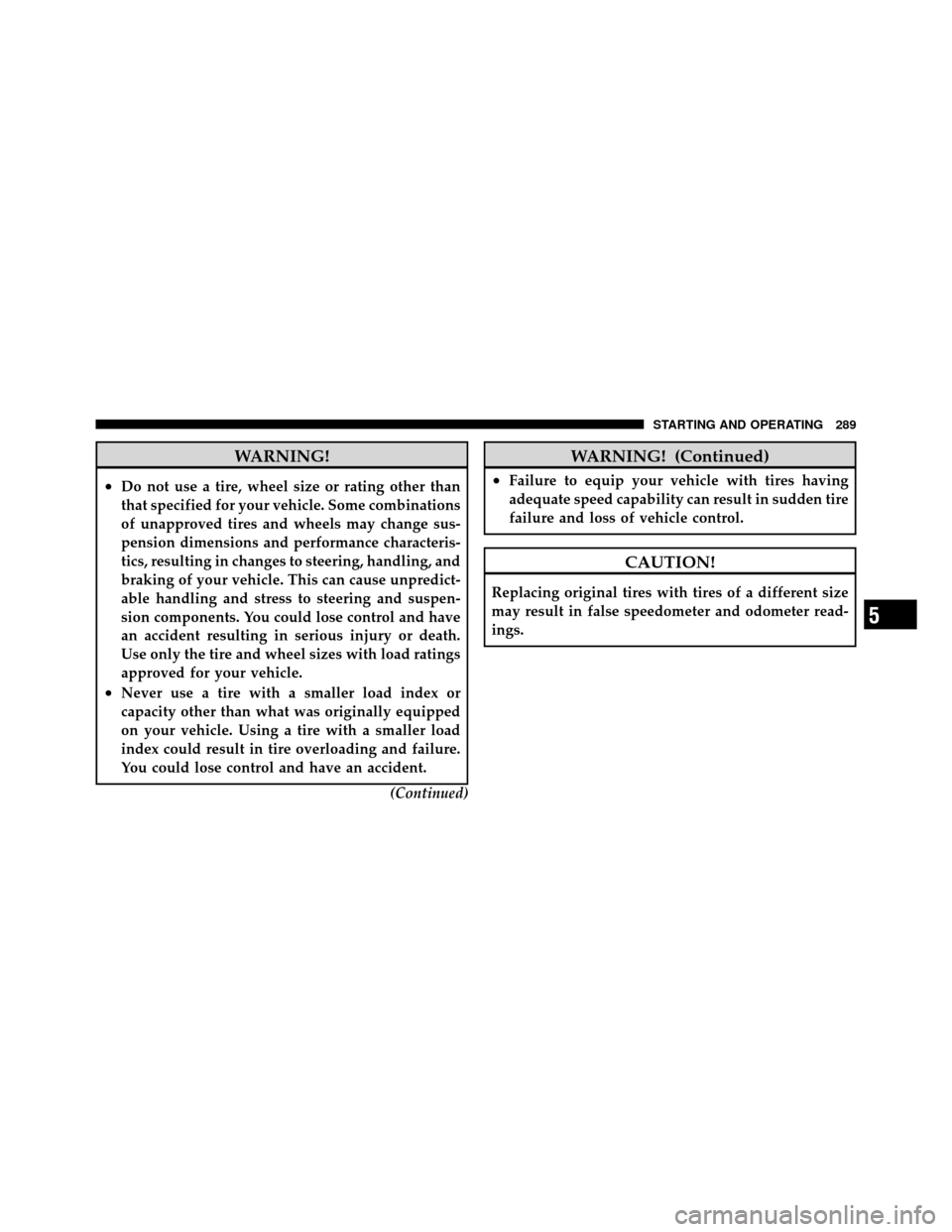
WARNING!
•Do not use a tire, wheel size or rating other than
that specified for your vehicle. Some combinations
of unapproved tires and wheels may change sus-
pension dimensions and performance characteris-
tics, resulting in changes to steering, handling, and
braking of your vehicle. This can cause unpredict-
able handling and stress to steering and suspen-
sion components. You could lose control and have
an accident resulting in serious injury or death.
Use only the tire and wheel sizes with load ratings
approved for your vehicle.
•Never use a tire with a smaller load index or
capacity other than what was originally equipped
on your vehicle. Using a tire with a smaller load
index could result in tire overloading and failure.
You could lose control and have an accident.(Continued)
WARNING! (Continued)
•Failure to equip your vehicle with tires having
adequate speed capability can result in sudden tire
failure and loss of vehicle control.
CAUTION!
Replacing original tires with tires of a different size
may result in false speedometer and odometer read-
ings.
5
STARTING AND OPERATING 289
Page 320 of 450
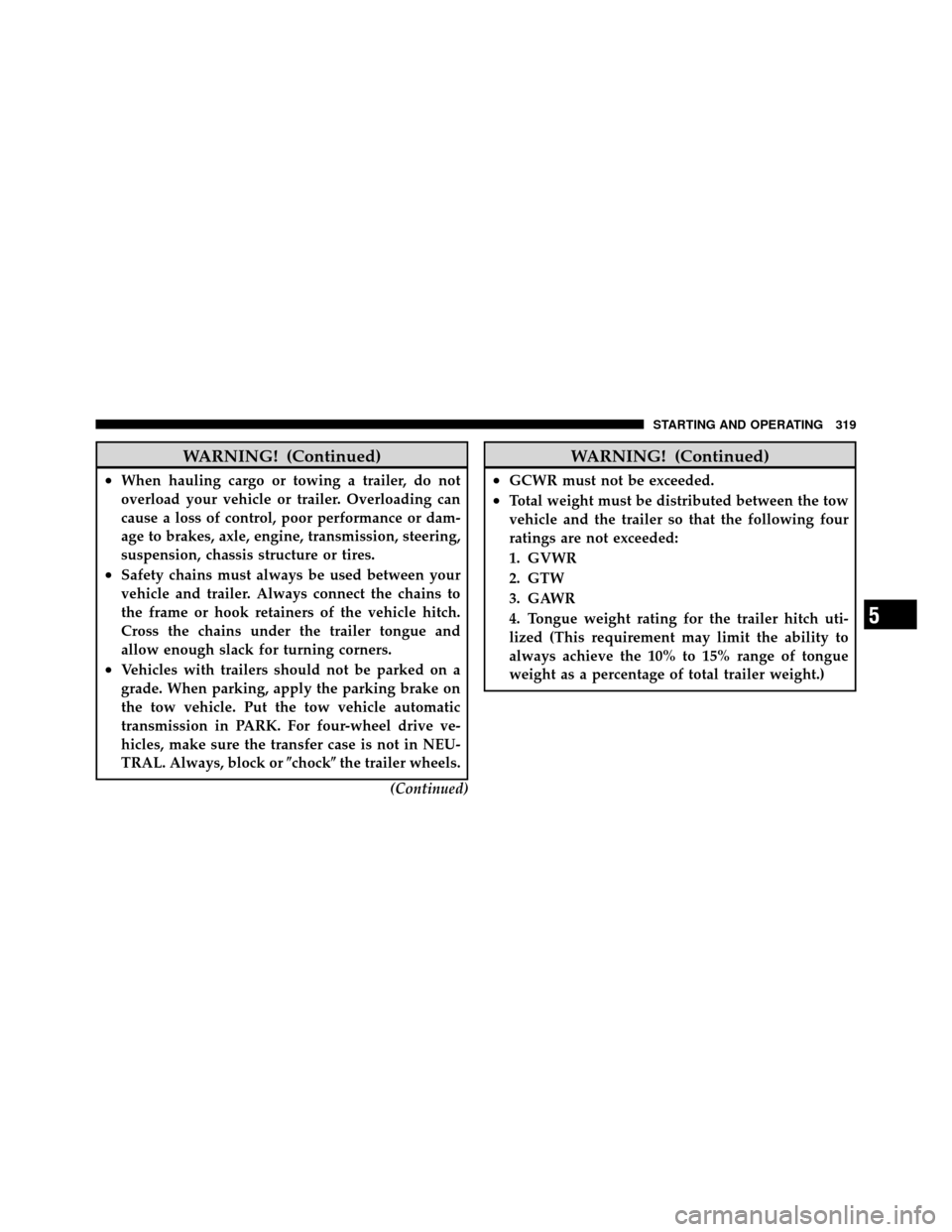
WARNING! (Continued)
•When hauling cargo or towing a trailer, do not
overload your vehicle or trailer. Overloading can
cause a loss of control, poor performance or dam-
age to brakes, axle, engine, transmission, steering,
suspension, chassis structure or tires.
•Safety chains must always be used between your
vehicle and trailer. Always connect the chains to
the frame or hook retainers of the vehicle hitch.
Cross the chains under the trailer tongue and
allow enough slack for turning corners.
•Vehicles with trailers should not be parked on a
grade. When parking, apply the parking brake on
the tow vehicle. Put the tow vehicle automatic
transmission in PARK. For four-wheel drive ve-
hicles, make sure the transfer case is not in NEU-
TRAL. Always, block or\bchock\bthe trailer wheels.
(Continued)
WARNING! (Continued)
•GCWR must not be exceeded.
•Total weight must be distributed between the tow
vehicle and the trailer so that the following four
ratings are not exceeded:
1. GVWR
2. GTW
3. GAWR
4. Tongue weight rating for the trailer hitch uti-
lized (This requirement may limit the ability to
always achieve the 10% to 15% range of tongue
weight as a percentage of total trailer weight.)
5
STARTING AND OPERATING 319
Page 333 of 450
HAZARD WARNING FLASHER
The Hazard Warning flasher switch is located on the top
of the steering column, just behind the steering wheel.Press the switch to turn on the Hazard Warning
flasher. When the switch is activated, all directional
turn signals will flash on and off to warn oncoming
traffic of an emergency. Press the switch a second time to
turn off the Hazard Warning flasher.
This is an emergency warning system and should not be
used when the vehicle is in motion. Use it when your
vehicle is disabled and is creating a safety hazard for
other motorists.
If it is necessary to leave the vehicle to go for service, the
Hazard Warning flasher will continue to operate with the
ignition key removed and the vehicle locked.
NOTE: With extended use, the Hazard Warning flasher
may wear down your battery.
Hazard Warning Flasher Switch
332 WHAT TO DO IN EMERGENCIES
Page 438 of 450
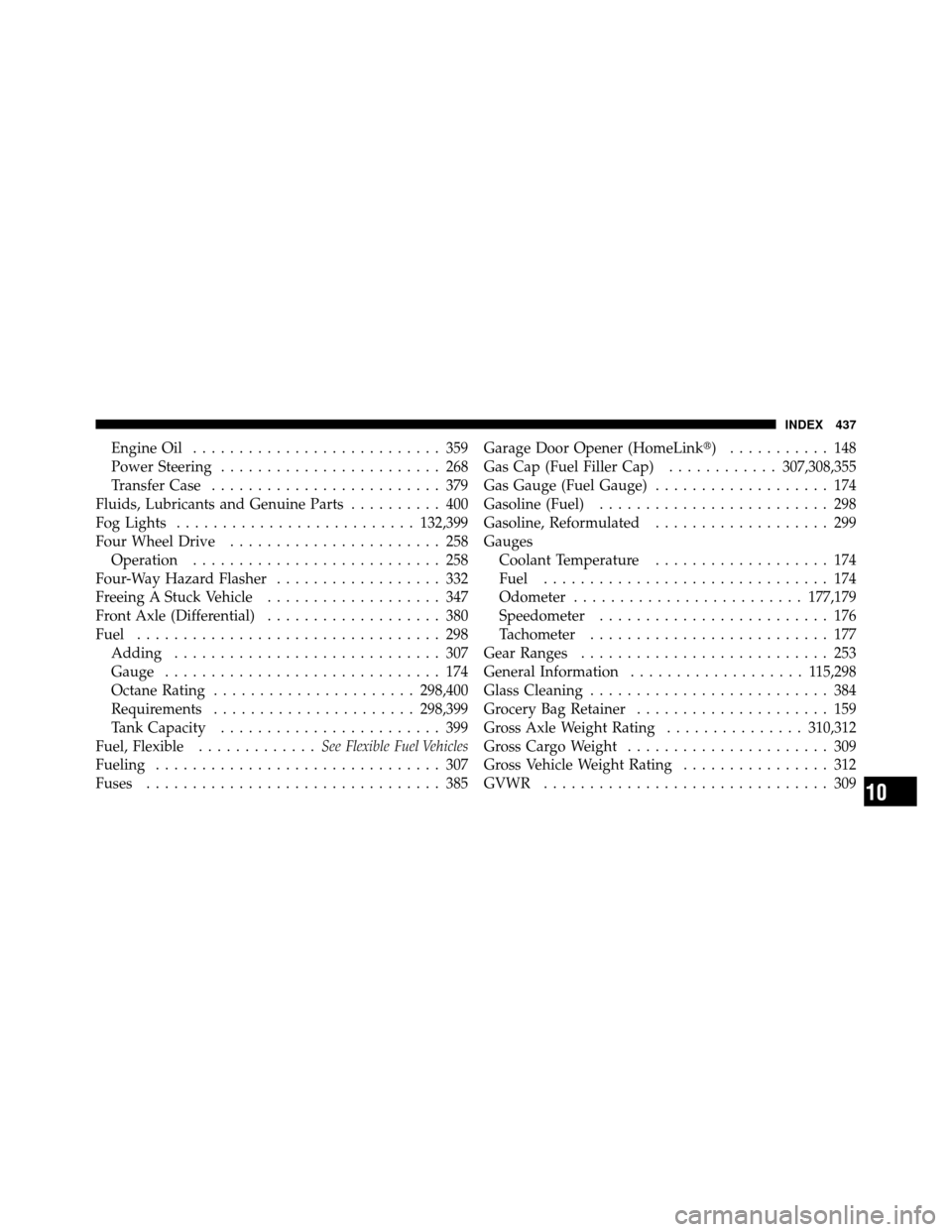
Engine Oil........................... 359
Power Steering ........................ 268
Transfer Case ......................... 379
Fluids, Lubricants and Genuine Parts .......... 400
Fog Lights .......................... 132,399
Four Wheel Drive ....................... 258
Operation ........................... 258
Four-Way Hazard Flasher .................. 332
Freeing A Stuck Vehicle ................... 347
Front Axle (Differential) ................... 380
Fuel ................................. 298
Adding ............................. 307
Gauge .............................. 174
Octane Rating ...................... 298,400
Requirements ...................... 298,399
Tank Capacity ........................ 399
Fuel, Flexible ............. See Flexible Fuel Vehicles
Fueling ............................... 307
Fuses ................................ 385 Garage Door Opener (HomeLink�) ........... 148
Gas Cap (Fuel Filler Cap)
............307,308,355
Gas Gauge (Fuel Gauge) ................... 174
Gasoline (Fuel) ......................... 298
Gasoline, Reformulated ................... 299
Gauges Coolant Temperature ................... 174
Fuel ............................... 174
Odometer ......................... 177,179
Speedometer ......................... 176
Tachometer .......................... 177
Gear Ranges ........................... 253
General Information ................... 1 15,298
Glass Cleaning .......................... 384
Grocery Bag Retainer ..................... 159
Gross Axle Weight Rating ...............310,312
Gross Cargo Weight ...................... 309
Gross Vehicle Weight Rating ................ 312
GVWR ............................... 309
10
INDEX 437
Page 441 of 450
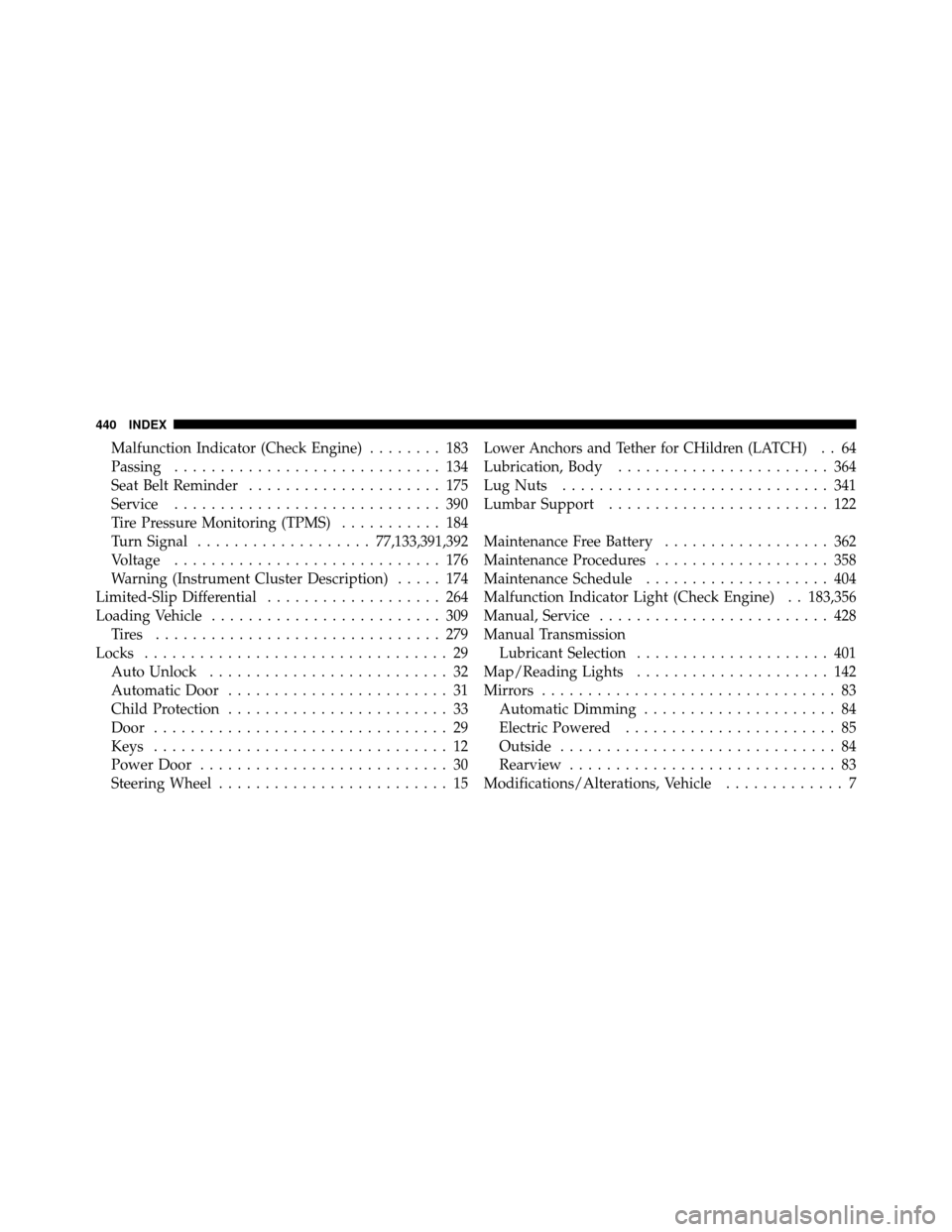
Malfunction Indicator (Check Engine)........ 183
Passing ............................. 134
Seat Belt Reminder ..................... 175
Service ............................. 390
Tire Pressure Monitoring (TPMS) ........... 184
Turn Signal ................... 77,133,391,392
Voltage ............................. 176
Warning (Instrument Cluster Description) ..... 174
Limited-Slip Differential ................... 264
Loading Vehicle ......................... 309
Tires ............................... 279
Locks ................................. 29
Auto Unlock .......................... 32
Automatic Door ........................ 31
Child Protection ........................ 33
Door ................................ 29
Keys ................................ 12
Power Door ........................... 30
Steering Wheel ......................... 15Lower Anchors and Tether for CHildren (LATCH).. 64
Lubrication, Body ....................... 364
Lug Nuts ............................. 341
Lumbar Support ........................ 122
Maintenance Free Battery .................. 362
Maintenance Procedures ................... 358
Maintenance Schedule .................... 404
Malfunction Indicator Light (Check Engine) . . 183,356
Manual, Service ......................... 428
Manual Transmission Lubricant Selection ..................... 401
Map/Reading Lights ..................... 142
Mirrors ................................ 83
Automatic Dimming ..................... 84
Electric Powered ....................... 85
Outside .............................. 84
Rearview ............................. 83
Modifications/Alterations, Vehicle ............. 7
440 INDEX